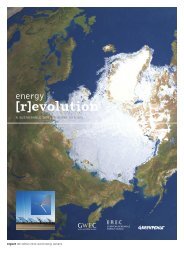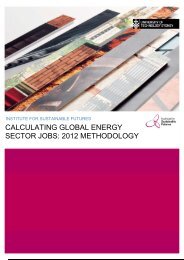download the mexico energy revolution scenario
download the mexico energy revolution scenario
download the mexico energy revolution scenario
Create successful ePaper yourself
Turn your PDF publications into a flip-book with our unique Google optimized e-Paper software.
The issue of security of supply is now at <strong>the</strong> top of <strong>the</strong> <strong>energy</strong> policy<br />
agenda. Concern is focused both on price security and <strong>the</strong> security of<br />
physical supply. At present around 80% of global <strong>energy</strong> demand is<br />
met by fossil fuels. The unrelenting increase in <strong>energy</strong> demand is<br />
matched by <strong>the</strong> finite nature of <strong>the</strong>se resources. At <strong>the</strong> same time,<br />
<strong>the</strong> global distribution of oil and gas resources does not match <strong>the</strong><br />
distribution of demand. Some countries have to rely almost entirely<br />
on fossil fuel imports. The maps on <strong>the</strong> following pages provide an<br />
overview of <strong>the</strong> availability of different fuels and <strong>the</strong>ir regional<br />
distribution. Information in this chapter is based partly on <strong>the</strong> report<br />
‘Plugging <strong>the</strong> Gap’ 60 , as well as information from <strong>the</strong> International<br />
Energy Agency’s World Energy Outlook 2008 and 2009 reports.<br />
status of global fuel supplies<br />
Oil is <strong>the</strong> lifeblood of <strong>the</strong> modern global economy, as <strong>the</strong> effects of<br />
<strong>the</strong> supply disruptions of <strong>the</strong> 1970s made clear. It is <strong>the</strong> number<br />
one source of <strong>energy</strong>, providing 32% of <strong>the</strong> world’s needs and <strong>the</strong><br />
fuel employed almost exclusively for essential uses such as<br />
transportation. However, a passionate debate has developed over <strong>the</strong><br />
ability of supply to meet increasing consumption, a debate obscured<br />
by poor information and stirred by recent soaring prices.<br />
<strong>the</strong> reserves chaos<br />
Public data about oil and gas reserves is strikingly inconsistent, and<br />
potentially unreliable for legal, commercial, historical and<br />
sometimes political reasons. The most widely available and quoted<br />
figures, those from <strong>the</strong> industry journals Oil & Gas Journal and<br />
World Oil, have limited value as <strong>the</strong>y report <strong>the</strong> reserve figures<br />
provided by companies and governments without analysis or<br />
verification. Moreover, as <strong>the</strong>re is no agreed definition of reserves or<br />
standard reporting practice, <strong>the</strong>se figures usually stand for different<br />
physical and conceptual magnitudes. Confusing terminology -<br />
‘proved’, ‘probable’, ‘possible’, ‘recoverable’, ‘reasonable certainty’ -<br />
only adds to <strong>the</strong> problem.<br />
Historically, private oil companies have consistently underestimated<br />
<strong>the</strong>ir reserves to comply with conservative stock exchange rules and<br />
through natural commercial caution. Whenever a discovery was<br />
made, only a portion of <strong>the</strong> geologist’s estimate of recoverable<br />
resources was reported; subsequent revisions would <strong>the</strong>n increase <strong>the</strong><br />
reserves from that same oil field over time. National oil companies,<br />
mostly represented by OPEC (Organisation of Petroleum Exporting<br />
Countries), have taken a very different approach. They are not subject<br />
to any sort of accountability and <strong>the</strong>ir reporting practices are even<br />
less clear. In <strong>the</strong> late 1980s, <strong>the</strong> OPEC countries blatantly overstated<br />
<strong>the</strong>ir reserves while competing for production quotas, which were<br />
allocated as a proportion of <strong>the</strong> reserves. Although some revision was<br />
needed after <strong>the</strong> companies were nationalised, between 1985 and<br />
1990, OPEC countries increased <strong>the</strong>ir apparent joint reserves by<br />
82%. Not only were <strong>the</strong>se dubious revisions never corrected, but<br />
many of <strong>the</strong>se countries have reported untouched reserves for years,<br />
even if no sizeable discoveries were made and production continued<br />
at <strong>the</strong> same pace. Additionally, <strong>the</strong> Former Soviet Union’s oil and gas<br />
reserves have been overestimated by about 30% because <strong>the</strong> original<br />
assessments were later misinterpreted.<br />
Whilst private companies are now becoming more realistic about<br />
<strong>the</strong> extent of <strong>the</strong>ir resources, <strong>the</strong> OPEC countries hold by far <strong>the</strong><br />
majority of <strong>the</strong> reported reserves, and <strong>the</strong>ir information is as<br />
unsatisfactory as ever. Their conclusions should <strong>the</strong>refore be treated<br />
with considerable caution. To fairly estimate <strong>the</strong> world’s oil<br />
resources a regional assessment of <strong>the</strong> mean backdated (i.e.<br />
‘technical’) discoveries would need to be performed.<br />
non-conventional oil reserves<br />
A large share of <strong>the</strong> world’s remaining oil resources is classified as<br />
‘non-conventional’. Potential fuel sources such as oil sands, extra<br />
heavy oil and oil shale are generally more costly to exploit and <strong>the</strong>ir<br />
recovery involves enormous environmental damage. The reserves of<br />
oil sands and extra heavy oil in existence worldwide are estimated<br />
to amount to around 6 trillion barrels, of which between 1 and 2<br />
trillion barrels are believed to be recoverable if <strong>the</strong> oil price is high<br />
enough and <strong>the</strong> environmental standards low enough.<br />
One of <strong>the</strong> worst examples of environmental degradation resulting<br />
from <strong>the</strong> exploitation of unconventional oil reserves is <strong>the</strong> oil sands<br />
that lie beneath <strong>the</strong> Canadian province of Alberta and form <strong>the</strong><br />
world’s second-largest proven oil reserves after Saudi Arabia.<br />
Producing crude oil from <strong>the</strong>se ‘tar sands’ - a heavy mixture of<br />
bitumen, water, sand and clay found beneath more than 54,000<br />
square miles 61 of prime forest in nor<strong>the</strong>rn Alberta, an area <strong>the</strong> size<br />
of England and Wales - generates up to four times more carbon<br />
dioxide, <strong>the</strong> principal global warming gas, than conventional drilling.<br />
The booming oil sands industry will produce 100 million tonnes of<br />
CO2 a year (equivalent to a fifth of <strong>the</strong> UK’s entire annual<br />
emissions) by 2012, ensuring that Canada will miss its emission<br />
targets under <strong>the</strong> Kyoto treaty. The oil rush is also scarring a<br />
wilderness landscape: millions of tonnes of plant life and top soil<br />
are scooped away in vast opencast mines and millions of litres of<br />
water diverted from rivers. Up to five barrels of water are needed<br />
to produce a single barrel of crude and <strong>the</strong> process requires huge<br />
amounts of natural gas. It takes two tonnes of <strong>the</strong> raw sands to<br />
produce a single barrel of oil.<br />
gas<br />
Natural gas has been <strong>the</strong> fastest growing fossil <strong>energy</strong> source over <strong>the</strong><br />
last two decades, boosted by its increasing share in <strong>the</strong> electricity<br />
generation mix. Gas is generally regarded as an abundant resource<br />
and public concerns about depletion are limited to oil, even though<br />
few in-depth studies address <strong>the</strong> subject. Gas resources are more<br />
concentrated, and a few massive fields make up most of <strong>the</strong> reserves.<br />
The largest gas field in <strong>the</strong> world holds 15% of <strong>the</strong> Ultimate<br />
Recoverable Resources (URR), compared to 6% for oil.<br />
Unfortunately, information about gas resources suffers from <strong>the</strong> same<br />
bad practices as oil data because gas mostly comes from <strong>the</strong> same<br />
geological formations, and <strong>the</strong> same stakeholders are involved.<br />
60 ‘PLUGGING THE GAP - A SURVEY OF WORLD FUEL RESOURCES AND THEIR IMPACT ON<br />
THE DEVELOPMENT OF WIND ENERGY’, GLOBAL WIND ENERGY COUNCIL/RENEWABLE<br />
ENERGY SYSTEMS, 2006.<br />
61 THE INDEPENDENT, 10 DECEMBER 2007<br />
69<br />
7<br />
<strong>energy</strong> sources and security of supply | STATUS OF GLOBAL FUEL SUPPLIES



![Energy [R]evolution - European Commission](https://img.yumpu.com/49109324/1/184x260/energy-revolution-european-commission.jpg?quality=85)


![5905 gp [eu rev]csfr4.qxd - Energy [R]evolution](https://img.yumpu.com/42305023/1/184x260/5905-gp-eu-revcsfr4qxd-energy-revolution.jpg?quality=85)


![5905 gp [eu rev]csfr4.qxd - Energy [R]evolution](https://img.yumpu.com/28729264/1/184x260/5905-gp-eu-revcsfr4qxd-energy-revolution.jpg?quality=85)